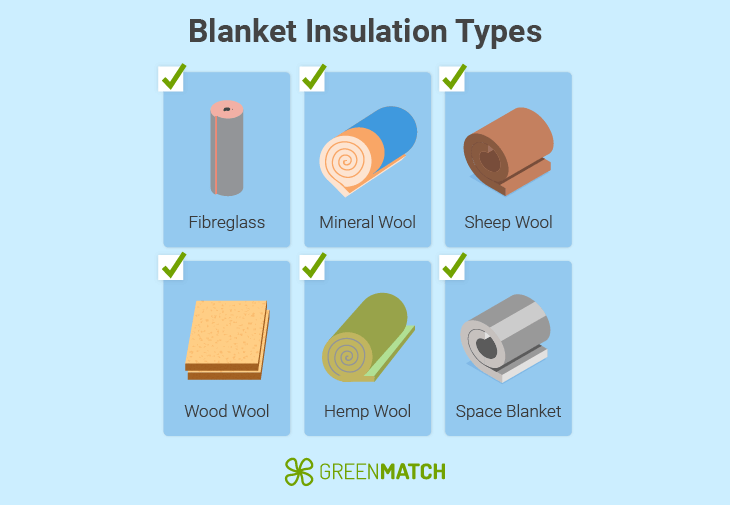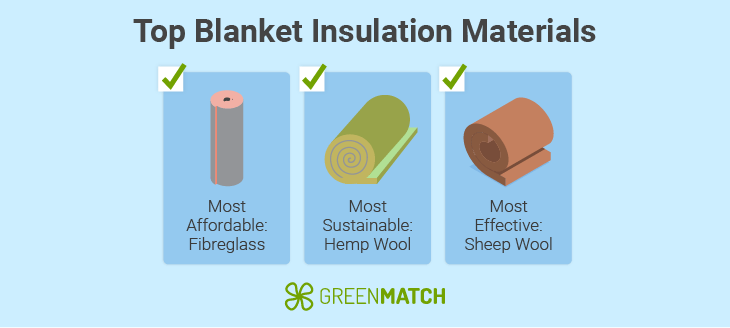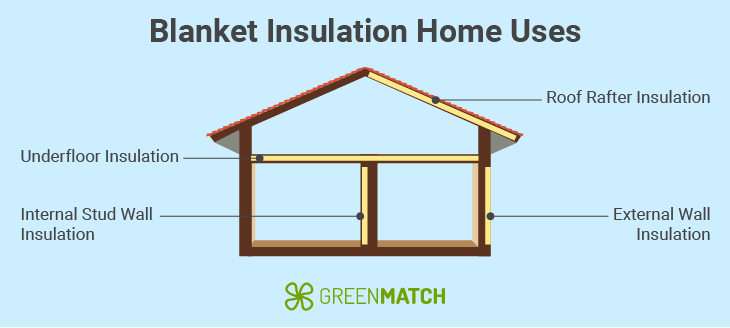Answer these simple questions and we will find you the BEST prices
Which type of solar quotes do you need?
It only takes 30 seconds
100% free with no obligation

Get Free quotes from insulation specialists near you

Save money by comparing quotes and choosing the most competitive offer

The service is 100% free and with no obligation
- GreenMatch
- Insulation
- Blanket Insulation
Ultimate Guide to Blanket Insulation UK (2025)


- Mineral wool and fibreglass are popular blanket insulation materials, but other eco-alternatives include sheep's wool, wood wool, and hemp wool.
- On average, blanket insulation can cost anywhere between £10 - £25 per m2, depending on your choice of material.
- Blanket insulation materials are popular for their affordability, ease of installation, and versatility, making them great for wall, loft, and even floor insulation.
With energy efficiency becoming a forefront concern throughout the UK, home insulation has become vital to achieving Net Zero by 2050. In the search for affordable and effective insulation solutions, blanket insulation materials have become one of the most popular choices, and for good reason.
Fair prices, sustainable production, and high versatility make thermal blanket insulation a popular choice for any home. This ultimate guide by GreenMatch UK will walk you through everything you need to know, including types of blanket insulation, pros, cons and costs.
Ready to insulate your home? Look no further than GreenMatch UK for a one-stop solution to all your insulation needs. Instead of spending endless hours online, spend just 30 seconds filling out our online form, and receive up to 3 free home-tailored quotes from our network of trusted installers. No costs, no obligations. Click below to begin!
- Describe your needs
- Get free quotes
- Choose the best offer
It only takes 30 seconds



What is blanket insulation?
Simply put, insulating blanket materials are compressed sheets or blankets of material, usually wrapped into batts for easier transport. The soft blanket-like structure of this insulating material serves a dual purpose:
- Versatility: The soft malleability of blanket insulation makes it a very versatile material to work with, allowing it to wrap around awkward shapes with ease, unlike rigid insulation.
- Moisture control: The porousness of blanket insulation helps control moisture buildup, allowing plenty of ventilation for vapour to evaporate, keeping the insulation and your home free from water damage.
The most common blanket insulation materials are fibreglass and mineral wool, but there are plenty of other options, complete with their properties and costs worth considering.
Different types of blanket insulation

Insulated blanket materials comprise one of the widest varieties of insulation available on the market, with options for every budget, purpose and preference. Here’s a breakdown of the most common blanket insulation materials:
- Fibreglass: Made from recycled glass woven into sheets, this blanket-like material is commonly used as a loft or suspended timber floor insulation. Being one of the cheapest on the market, it is most popular for its affordability, as well as resistance to flame, moisture, and mould.
- Mineral wool: Similar to fibreglass, mineral wool is derived from rock or glass, and spun into blanket-like structures. Providing better heat retention than its counterpart, mineral wool is one of the most common and versatile blanket insulators on the market.
- Sheep wool: A sustainable, hypoallergenic and fully biodegradable blanket insulation made from surplus wool from annual sheep shearing. Sheep wool provides remarkable heat retention as a natural material and ensures a minimal ecological footprint as well.
- Wood wool: This all-natural blanket that is made of wood fibres is a sustainable insulation product that boasts great thermal performance, as well as flame resistance. Its semi-porous nature also allows for ventilation, reducing the risk of moisture buildup.
- Hemp wool: Made from the fibres of the hemp plant, this blanket is particularly sustainable as the hemp plant is very easy to grow, requiring very little water and no pesticides.
- Space blanket: Also known as aerogel, a space blanket is a synthetic low-density material formed by removing liquid from a gel, creating a microporous structure that is 99% air. It was originally developed for space travel by NASA but can be found as light heat-reflective plastic sheets used to increase heat retention in your home.
Ultimately, the best choice for your property will hinge on practical and personal factors. That's why, it's recommended to work with a professional installer who can assess your property and tailor the best course of action for your needs.
Which blanket insulation is best?

The best-insulated blankets depend on your definition of best. For example, the most affordable blanket insulation may not be the most thermally effective, or the most effective may not be the most sustainable.
In terms of popularity, mineral wool is likely the best insulation material overall, however, let’s have a look at which insulation materials perform best per the criteria:
- Most affordable: The most budget-friendly option is most definitely fibreglass. On average costing just £10 per m2, fibreglass is one of the cheapest of all insulation materials. Granted, this is accompanied by less thermal efficiency, but this can be justified by its affordability.
- Most sustainable: Due to the low-resource demanding production, hemp wool stands out as one of the most sustainable blanket insulators. The hemp plant is notoriously resistant, requiring very little water and no pesticides to grow. This keeps the planet clean and reduces resource needs in production. Hemp is also fully biodegradable.
- Most effective: In terms of performance, sheep wool stands out as one of the most thermally effective, boasting a u-value of 0.22 - 0.29 W/m²K. This is better resistance to heat than fibreglass and mineral wool. In addition, sheep's wool is hypoallergenic, making it a healthy material to work with.
Gauging your needs and preferences can help narrow down the best choices for you. For extra guidance, we recommend working with an accredited installer who can assess your property and provide tailored advice on material choices.
Where insulation blankets are commonly used

Blanket insulation materials are most applauded for their versatility, making them suitable for use in almost all home insulation projects. The malleable structure of a thermal insulation blanket also helps insulate around awkward shapes and crevices that rigid insulation cannot account for.
Blanket loft insulation is the most common use of this group of materials. This is because blankets can be cut to fit with ease between floor joists and roof rafters, making great insulation for loft purposes. In other uses, blanket insulation makes for great insulation for walls, both internal and external, as well as cavity wall insulation on some occasions.
Pros and cons of insulation blanket
You may be tempted to make a choice already, but assessing the advantages and disadvantages of blanket insulation is an important step to forming an educated opinion. Let’s have a look at the key pros and cons of this insulation group.
- Sustainable: Blanket insulation materials are collectively some of the most sustainable in raw materials, production, and potential for recycling. The majority of these insulators are either partially or fully derived from recycled materials and are biodegradable.
- Affordable: In terms of budget-friendliness, blanket insulation boasts some of the most affordable options, such as fibreglass and mineral wool. While these materials may be less thermally efficient, their price makes them worthwhile.
- Versatile: The soft malleable properties of blanket insulation make them suitable for almost any home insulation job, from lofts to floors, walls to roofs. They allow the insulation of awkward crevices, shapes and gaps with ease.
- High thickness: Due to the lower heat retention of these materials, blanket insulation requires at least 270mm thickness to achieve building regulations. In comparison, only about 120mm of rigid insulation board is needed for the same effect.
- Low durability: Blanket insulation materials are less rigid and durable against weathering, making them more susceptible to moisture ingress, clumping and even degradation when compared to other insulation materials.
- Health risks: In particular, mineral wool and fibreglass are materials that can highly irritate the skin upon direct contact. In addition, airborne particles can cause respiratory issues if inhaled. For this reason, protective gear is necessary when installing.
Like any insulation material, the pros and cons can differ also based on your home circumstances. To make the most effective decision, consider hiring a professional installer who can tailor the best course of action for your needs.
How much does blanket insulation cost?
Blanket insulation material prices can vary greatly based on properties, production and application. Nonetheless, they tend to be more affordable than other insulation types. As a rule of thumb, more expensive materials tend to be more effective.
To help narrow your options, here’s a breakdown of common blanket insulation materials and their costs per m2:
| Insulation material | Average cost per m2 (£) |
|---|---|
| Fibreglass | £10 |
| Mineral wool | £13 - £17.5 |
| Sheep wool | £17.5 - £22 |
| Wood wool | £16.5 - £20 |
| Hemp wool | £10 - £25 |
It’s important to keep in mind that these costs are estimates based on market averages, and the most accurate investment can be calculated by a professional installer after your needs have been assessed.
For more expensive materials, consider looking into home insulation grants, as qualifying households can receive partial or full cost coverage for insulation jobs.
Why choose insulation blankets over other insulation types?
Weighing all the pros and cons, blanket insulation stands out as one of the most beneficial insulation options. Besides being some of the most affordable and versatile materials, blanket insulation ensures the most eco-friendly approach to insulating your home, given they mostly derive from sustainable raw materials or recycled goods.
Nonetheless, choosing the right material is the beginning of the journey. The next step is to choose the right installer, which is not always so easy. Most prospective customers find themselves stuck in an endless loop of researching and vetting online, with no bargain in sight. Luckily, GreenMatch UK can free you of this burden.
Through our services, all it takes is a 30-second intake form to receive up to 3 free home-tailored quotes from our network of pre-vetted professionals. The best part? Our services are free of charges and obligations. Simply click below to begin, and let the bargains come to you!
- Describe your needs
- Get free quotes
- Choose the best offer
It only takes 30 seconds



FAQ
Blanket insulation materials are semi-porous sheets derived from a range of sustainable materials such as rock, glass, wood or hemp. Their malleable nature makes them very versatile in home insulation applications, as well as allows for great moisture control.
Blanket insulation is considered one of the most popular home insulation approaches, due to its affordability, versatility and sustainability.
Blanket insulation materials are not as thermally efficient as most of their counterparts, requiring a high thickness of at least 270mm to achieve good heat retention. In addition, they are not as durable against damage and weatherproofing as rigid options, being more prone to moisture ingress, clumping and degradation.
Space blanket – or aerogel insulation – is a highly effective material with low density that is almost 99% air. This makes for an incredibly light, yet effective thermal material that boasts an impressive ability to maintain internal temperatures.
The costs of blanket insulation vary greatly depending on the material you opt for. On average, the cost range for all blanket insulation types sits around £10 – £25 per m2, depending on your choice of material, thickness, and condition.

Akif is a copywriter at GreenMatch since 2023. With a keen interest in community sustainability, green solutions and the role of digital media in identifying climate trends, he aims to hone in on his background in International Studies and Digital Media to provide a multidisciplinary approach to written content rooted in credible research and accuracy.
We strive to connect our customers with the right product and supplier. Would you like to be part of GreenMatch?

